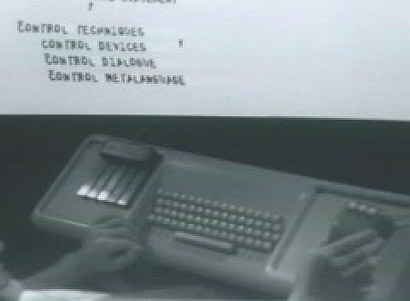
There’s something about 1950’s and 1960’s black and white video recordings that I find hypnotic and deeply compelling, particularly when they document important or interesting people and events. From the 1969 moon landing to the Eichmann trials, these videos mesmerize me. Every frame has an eerie, spectral glow, making faces and people a little bit translucent, ephemeral — a kind of animated equivalent of daguerrotypes, a spiritualist medium channeling voices from another world.
My favorite video of this genre is Doug Englebart’s 1968 live demo of his new invention, the computer mouse, which he and his team produced at the Stanford Research Institute in Menlo Park, CA.
Englebart’s mouse is not simply a primitive prototype of the mouse we know today. The Englebart mouse sprung from the labs fully-formed, with almost all of the features we expect a mouse to have today: three buttons, a persistent on-screen pointer. To make the mouse even more useful, he also introduced some key GUI software innovations like clickable hyperlinks, context menus, drag-n-dropping, and more.

It’s interesting to note that Englebart’s mouse wasn’t even a single invention – a whole suite of additional user interface innovations came with it, mostly on the software side (I’ve always thought it was interesting that while we credit Alexander Graham Bell with the invention of the telephone, we neglect to realize that by doing so he simultaneously invented the microphone and the speaker, too).
In fact, it becomes fairly obvious while watching this that the main obstacle to the rapid broad adoption of his invention was the missing software innovation of the WIMP interface (Windows, Icons, Menus and Pointing device).
Still, his demonstrations are shockingly prescient. He even shows off a Google Maps-style application, where he can view a primitive “map” of his route home, pointing-and-clicking at the drugstore to see his shopping list.
And the clips are truly beautiful, with really nice overlay and split-screen compositions and a strangely resonant sound quality to his voice, speaking through his mission-control-style headset at his Herman Miller-designed workstation.
This video is a must-see for ambitious interaction designers. It’s the moon landing of the computer industry.